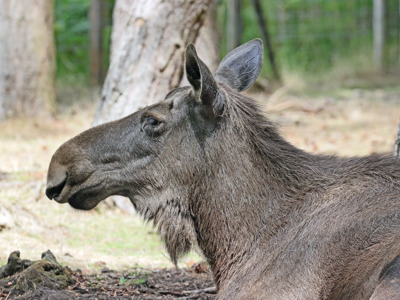
Eurasian Elk
Alces alces
The Eurasian elk is the largest member of the deer family. Elk have a heavy body, humped shoulders, long legs and a short tail. They’re easily recognisable by a skin fold under their chin known as a dewlap or bell and by their large, overhanging nose or proboscis, giving rise to a keen sense of smell.
Females (cows) lack antlers, whereas males (bulls) have impressive palmate (palm shaped) antlers that can stretch 2 metres across. They have two wide hooves on each foot, which splay, an advantage when walking on mud, snow and for swimming.

Habitat
Elk are found in a range of woodland habitats in cooler climates. Preferable habitats are those that provide patchy mosaics of forest, swamps, lakes and wetlands.

Behaviour
Elk are solitary and diurnal. Calves stay with their mother until they are around a year old. Rutting occurs from September to October, when bulls stop feeding entirely in order to compete for the mating rights to females. Cows select the bulls with the largest antlers and dewlap to mate with.
They can dive and feed underwater on aquatic plants below the surface by sealing off their enlarged nostrils. Will not only wade and swim in lakes and rivers, but also a crucial strategy in order to cool down in the warmer months.

Threats
General threats to all global populations are habitat modification through forestry and agricultural activities. Hunting is also thought to be an additional pressure contributing to the localised extinction in some areas such as in the UK.
Distribution
North American and Eurasian range. In Europe, its continuous range stretches from Norway and Sweden, across to Russia, the Baltic States and eventually China.
Diet
Herbivorous diet. Do not graze on grasses, but browse on the non- grass understory of forests, aquatic plants, and fruits as well as both deciduous and conifer trees.
UK Status
Currently now extinct in the UK although a small population possibly survived in Scotland up until around 900AD.
Wildwood inside information
We are lucky enough to have a female Elk called Caramel and a young male called Jurgen. Caramel was born at Whipsnade zoo, and came to Wildwood in 2013. She is very talkative, and regularly spends time chatting away to her keepers. Jurgen joined us from Germany in 2023. We are the only animal park to have an Elk pair.
Family facts
- Elk are known to eat up to 20kg of food per day; their full stomachs can weigh a whopping 65kg!
- Male Elks are called “bulls” and females are called “cows”.
- Elk are known to give birth to twins.

